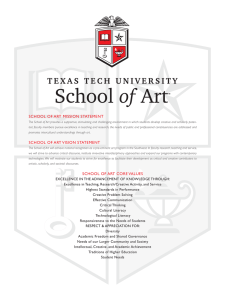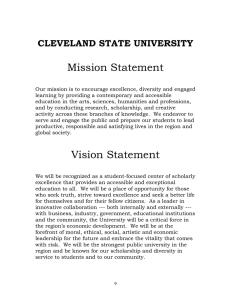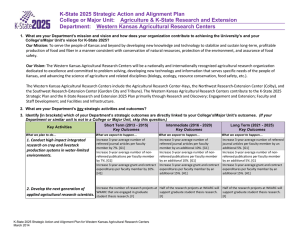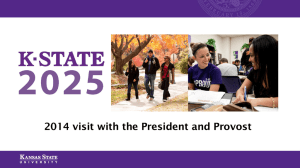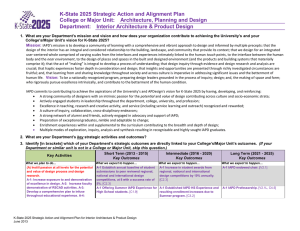K-State 2025 Strategic Action and Alignment Plan
advertisement
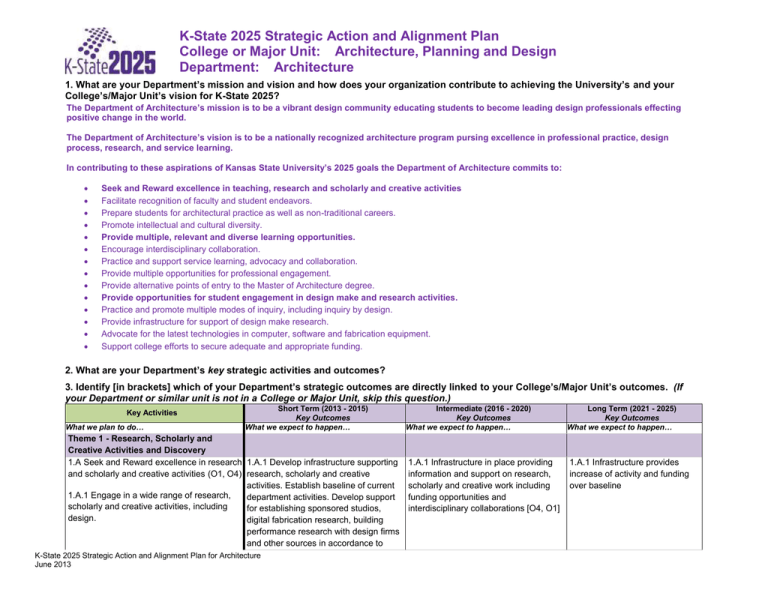
K-State 2025 Strategic Action and Alignment Plan College or Major Unit: Architecture, Planning and Design Department: Architecture 1. What are your Department’s mission and vision and how does your organization contribute to achieving the University’s and your College’s/Major Unit’s vision for K-State 2025? The Department of Architecture’s mission is to be a vibrant design community educating students to become leading design professionals effecting positive change in the world. The Department of Architecture’s vision is to be a nationally recognized architecture program pursing excellence in professional practice, design process, research, and service learning. In contributing to these aspirations of Kansas State University’s 2025 goals the Department of Architecture commits to: Seek and Reward excellence in teaching, research and scholarly and creative activities Facilitate recognition of faculty and student endeavors. Prepare students for architectural practice as well as non-traditional careers. Promote intellectual and cultural diversity. Provide multiple, relevant and diverse learning opportunities. Encourage interdisciplinary collaboration. Practice and support service learning, advocacy and collaboration. Provide multiple opportunities for professional engagement. Provide alternative points of entry to the Master of Architecture degree. Provide opportunities for student engagement in design make and research activities. Practice and promote multiple modes of inquiry, including inquiry by design. Provide infrastructure for support of design make research. Advocate for the latest technologies in computer, software and fabrication equipment. Support college efforts to secure adequate and appropriate funding. 2. What are your Department’s key strategic activities and outcomes? 3. Identify [in brackets] which of your Department’s strategic outcomes are directly linked to your College’s/Major Unit’s outcomes. (If your Department or similar unit is not in a College or Major Unit, skip this question.) Key Activities What we plan to do… Short Term (2013 - 2015) Key Outcomes What we expect to happen… Theme 1 - Research, Scholarly and Creative Activities and Discovery 1.A Seek and Reward excellence in research 1.A.1 Develop infrastructure supporting and scholarly and creative activities (O1, O4) research, scholarly and creative activities. Establish baseline of current 1.A.1 Engage in a wide range of research, department activities. Develop support scholarly and creative activities, including for establishing sponsored studios, design. digital fabrication research, building performance research with design firms and other sources in accordance to K-State 2025 Strategic Action and Alignment Plan for Architecture June 2013 Intermediate (2016 - 2020) Key Outcomes What we expect to happen… 1.A.1 Infrastructure in place providing information and support on research, scholarly and creative work including funding opportunities and interdisciplinary collaborations [O4, O1] Long Term (2021 - 2025) Key Outcomes What we expect to happen… 1.A.1 Infrastructure provides increase of activity and funding over baseline 1.B. Facilitate recognition of faculty and student RSCAD endeavors (O4, C4) 1.B.1 Submit research scholarly and creative work for review and publication or dissemination faculty interests. Promote design competitions [O4.5] 1.B.1 Develop infrastructure to distribute information and funding support for faculty engagement in dissemination of research, scholarly and creative products [O4.4, O4.3] Theme 2 - Undergraduate Educational Experience 2.A Encourage and reward broadminded and 2.A.1 Identify current collaborative critical thinking (O1) activities and potential activities inside and outside the college. Identify 2.A.1 Work with other departments to potential on-line courses. Encourage develop cross-disciplinary opportunities (C1) student participation in college foreign study programs [C1.6] 2.B Prepare students for architectural 2.B.1 Work with Architecture practice as well as non-traditional careers Professional Advisory Board and (T3-N) American Institute of Architecture to assess changes in the practice 2.B.1 Prepare students to enter an evolving environment. Strategies developed for professional context (V1, C2) alignment [C1.6] 2.B.2 Work with colleagues in the college to develop a non-professional design major 2.B.2 With the college, support the (V2, C1) formation of an interdisciplinary committee to develop a proposal 2.B.3 Facilitate curricular integration across (protocols, curriculum, market study, subject areas including relationship of core resource implications, etc.) for a noncourses in technology to design studio professional environmental design sequence (C1) degree [C3.4] 1.B.1 Increased dissemination of faculty and student work in scholarship, creative activity and research. Provide consistent funding support for new faculty development in RSCAD [O4.4] 1.B.1 Increase in the number of faculty and students recognized by peers for excellence in research, scholarly and creative work. Recognition as a leader in contributing to the discipline of architecture and architectural education [O4, C4, C2] 2.A.1 Offer jointly taught and/or offered courses including cross-curricular courses and on-line courses [C3.4] 2.A.1 Increase in the number of offerings jointly taught and/or offered core and elective courses including on-line courses 2.B.1 Curriculum accessed and refined in response to changes in the professional environment C3, V1] 2.B.1 Recognized leader in providing a relevant professional education to changing architectural practice [T3-N] 2.B.2 Seek approval for a new degree / recruit students / implement [C1.6, C3.4] 2.B.2 New degree in place [C3.4] 2.B.3 Recommendations of faculty on alignment and curricular placement of learning objectives implemented 2.B.3 Alignment and curricular placement of common learning strategies accessed to keep pace with changes in practice and technology [T6-K] 2.B.3 Support existing technology curriculum task force to access current learning objectives in the curriculum and provide recommendations [V3.3] Theme 3 - Graduate Scholarly Experience 3.A Promote intellectual and cultural diversity 3.A.1 Develop a proposal (define: entry through student opportunities (C1) requirements, curriculum, market potential, resource requirements, etc.). 3.A.1 Develop opportunities for individuals Begin marketing program [V2.4] with degrees in other fields or previous design education to pursue the MARCH K-State 2025 Strategic Action and Alignment Plan for Architecture June 2013 3.A.1 Admit first students. Refine the curriculum and entry requirements. Secure resources for additional faculty as required [V2.4, C4.6] 3.A.1 Enrollment of 12-15 students per year matriculating in alternative MARCH path. New faculty hired with additional resources degree (V2) 3.B Provide multiple, relevant & diverse learning opportunities (V5) 3.B.1 Develop opportunities for students to engage in non-traditional learning experiences, such as design-build projects and research projects (T4) 3.B.1 Support existing design-build studio(s) in fifth year. Continue to develop infrastructure departmentally and in collaboration with college to support faculty and students. Pilot a studio doing design-build with a research focus [V5.2, V5.3] 3.B.2 Expand areas of inquiry open to 3.B.2 Review areas of expertise students in Master of Science in Architecture available on the faculty and in the (O4) professional community. Access resources available and develop strategies to balance faculty teaching loads. Establish baseline. Begin marketing program [T5-F, V2.4] Theme 4 - Engagement, Extension, Outreach and Service 4.A Practice and support service-learning, 4.A.1 Continue support of current advocacy and collaboration (O2, O3) service-learning studios and projects. Develop protocols, and infrastructure for 4.A.1 Engage in studio projects that can service-learning efforts. Kansas City enlighten Kansas communities (T4) Design Center is an active part of program [O2.1, O3.1] 4.B.1 Encourage faculty and student involvement with professional organizations 4.B.2 Provide opportunities for practicing professionals to contribute to the educational experience (guest lecturers / critics / instructors) (O1) 4.B.1 Subsidize the costs of participation in professional organizations for faculty. Support and encourage student participation in the American Institute of Architecture Students and other organizations such as National Organization of Minority Architects [O1.1] 4.B.2 Support existing design studio partnerships with architectural firms. Broaden the pool of practitioners contributing to the curriculum 3.B.1 Formal infrastructure in place at department and college level. Seek funding for design-build and research studios and/or projects through grants or partnerships with design firms [V5.2] 3.B.1 Students have options to engage in design-build or design build research studios and/or projects [T3-I] 3.B.2 Offer a wider range of 3.B.2 Students admitted to work with options to graduate students and specific faculty in their area of expertise increase enrollment 50% over (some as graduate research assistants). baseline Faculty rewarded for work with MS students [V2.4, T3-D] 4.A.1 Infrastructure in place for faculty and student support of service-learning studios and projects. Seek external funding for projects [V2.4] 4.A.1 Students have opportunities to engage in service-learning studios and/or projects. Program recognized as a leader in service-learning 4.B.1 Recognize and reward leadership in professional organizations. Student chapters of professional organizations are an active part of the student experience 4.B.1 Partnered with professional organizations on issues of mutual concern. K-State architecture is a leader in faculty and student engagement with professional organizations 4.B.2 Seek funded sponsorships of design studio partnerships. Broaden participation beyond the region using on-line resources [V5.2] 4.B.2 Recognized leader in professional engagement Theme 5 - Faculty and Staff 5.A Seek and reward excellence in teaching, 5.A.1 Access and Investigate ways of research, and service (C4) strengthening existing mentoring programs. Identify current teaching, 5.A.1 Develop programs, such as mentoring, service and RSCAD strengths of faculty to help faculty members grow and advance [C4.2, C4.4] (T5) 5.A.1 Developed strategies supporting faculty and staff in achieving excellence in teaching, service and RSCAD. Means developed to reward excellence [O4.2, C6.2, C6.3] 5.B Encourage collaboration and collegiality 5.B.2 Access current interests of faculty 5.B.2 Collaborative engagement is part K-State 2025 Strategic Action and Alignment Plan for Architecture June 2013 5.A.1 Faculty recognized for excellence through awards and leadership [C6.3] 5.B.2 Opportunities for teamteaching and collaborative inquiry are supported through funding in comparison to other college and university faculty. Provide venues for social interaction of faculty culture and rewarded and other incentives 6.A.1 Architecture space needs for design-build, fabrication, prototyping, research, teaching and technology are filled. [I1.4, I1.5] 6.A.1 Facilities and technology are recognized for excellence Theme 6 - Facilities and Infrastructure 6.A Advocate for new and make good use of 6.A.1 Architecture facility and existing facilities and technologies technology needs are accessed and (V3, V5) represented in College facilities planning [I1.3] 6.B.1 Participate actively in the development of plans and policies to enhance the quality 6.B.1 Faculty and student contributions of the built environment inside and outside and potential for advocating high-quality the university built environments are identified [I1.5] 6.B.1 Faculty and students contribute design expertise to university community 6.B.1 Faculty and students contributions to the design of high-quality built environments are recognized at the university, city and state level 4a. What resources and/or opportunities exist for your Department to achieve its vision and outcomes? Several items listed above (2.B.2 & 3.A.1) have the potential to increase the number of students served, and thus will increase tuition revenue. 4b. What resources and/or opportunities are needed for your Department to achieve its vision and outcomes? Funds are needed to enhance faculty opportunities, either through direct support for research, scholarly and creative endeavors, or to provide release time for faculty to pursue these endeavors. 5. How do you propose to acquire the resources needed for your Department to accomplish its vision and outcomes? The departmental professional advisory board has started a campaign to provide a faculty development fund to provide supplemental support for faculty efforts. 6. How does your plan link to the K-State 2025 University Benchmark Metrics, Common Elements, and Thematic Goals, Outcomes, and Metrics? (See below) Linkages to 2025 themes - the matrix is organized by these themes. K-State 2025 Strategic Action and Alignment Plan for Architecture June 2013 6. Departmental Links to K-State 2025 University Benchmark Metrics, Common Elements, and Thematic Goals, Outcomes, and Metrics Links to Benchmark Metrics B-4 - Number of faculty awards B-8 - Percent of undergraduate students involved in research Links to Common Elements CE-2 - Culture CE-3 - Diversity CE-6 - International CE-8 - Technology Links to University Thematic Goals, Outcomes, and Metrics Links to 2025 Thematic Goals and Metrics T1 - Research, Scholarly and Creative Activities, and Discovery (RSCAD) Theme 1 Metrics: Links to Short Term Outcomes (2011 – 2015) Links to Intermediate Outcomes (2016 – 2020) Links to Long Term Outcomes (2021 – 2025) T1-A - Increased intellectual and financial capital to support RSCAD T1-I - Intellectual and financial capital in place for expanded RSCAD efforts T1-Q - Competitive amongst our peers in the percentage of undergraduates involved in research T1-H - Enhanced visibility and appreciation for research, discovery, and scholarly and creative activities T1-L - Recognized for prominent and productive placement of our graduates T1-3 - # of juried, adjudicated, or externally vetted performances, shows and designs T1-M - Increased participation by undergraduates in expanded opportunities in research T1-4 - # of refereed scholarly publications per academic year and allocated faculty member T2 - Undergraduate Educational Experience (UEE) Theme 2 Metrics: T2-1 - # and % of undergraduate students participating in a meaningful international experience T2-2 - # and % of undergraduate students completing an experiential learning experience T2-B - Engaged students benefitting from high impact educational practices used by excellent faculty and staff across the university T2-I - Integrated learning communities experienced by students, faculty, and staff that promote student success within a culture of excellence T2-E - Effective evaluation practices that recognize and reward teaching, advising, and life-long learning/professional development T2-J - Excellent reputation for high quality teaching and advising that prepares students for their professional, community, social, and personal lives T2-F - Effective system in place that supports and promotes teaching excellence T2-K - Superior and diverse faculty recognized for teaching excellence T2-G - Successful recruitment and retention strategies that address our entire student population T2-L - All UG students engaged in a diversity of experiences that expand their viewpoint K-State 2025 Strategic Action and Alignment Plan for Architecture June 2013 Links to University Thematic Goals, Outcomes, and Metrics Links to 2025 Thematic Goals and Metrics Links to Short Term Outcomes (2011 – 2015) T3 - Graduate Scholarly Experience T3-E - Expectation of excellence for the graduate scholarly experience Theme 3 Metrics: T3-H - Expanded partnerships with industry and government to provide high level learning and experiential training opportunities for graduate students T3-4 - # of private/public sector partnerships supporting graduate experiential training opportunities T3-5 - # of graduate students participating in a unique high level learning and experiential training Links to Intermediate Outcomes (2016 – 2020) Links to Long Term Outcomes (2021 – 2025) T3-I - Increased participation by our graduate students in unique high level learning and experiential training T3-N - National and international reputation for outstanding graduates with demonstrable career success T3-J - Expanded reputation for outstanding graduates with the critical skill sets needed to excel in their careers in a global environment T3-O - World-class reputation as a preferred destination for outstanding graduate students T3-K - Increased funding for graduate research and teaching T3-L - Increased number of nationally and internationally recognized awardwinning graduate faculty T4 - Engagement, Extension, Outreach and Service T4-A - Enhanced integration between academics and student service learning Theme 4 Metrics: T4-B - Increased participation by undergraduates in expanded opportunities for meaningful Engagement experiences T4-1 - # and % of undergraduate students participating in engagement/service learning T4-5 - # of participants involved in community-based research and outreach projects T4-6 - Economic impacts on rural and urban communities in Kansas T4-C - Increased recognition of our services as a source of expertise, information, and tools for disciplines worldwide T4-D - Increased numbers and diversity of faculty and staff participating in Engagement T4-F - Recognition as leaders in Engagement within our state and nation K-State 2025 Strategic Action and Alignment Plan for Architecture June 2013 T4-H - Exposure on a national level as a leader/partner engaged in significant social, political, health, economic and, environmental issues T4-I - All undergraduate students engaged in at least one engagement /service learning project T4-J - Increased number of graduate students involved in Engagement T4-K - Increased appreciation by KState graduates for lifelong involvement in engagement and service T4-M - Preferred destination for faculty, staff, and students who value Engagement as integral to their academic and personal lives T4-P - Recognized as a leader in Engagement reaching both rural and urban communities Links to University Thematic Goals, Outcomes, and Metrics Links to 2025 Thematic Goals and Metrics T5 - Faculty and Staff Theme 5 Metrics: Links to Short Term Outcomes (2011 – 2015) T5-C - Career-long learning recognized by the university and its employees as a shared value and responsibility T5-1 - # of national and international faculty awards T5-3 - Competitive compensation packages for faculty and staff T5-7 - % of faculty and staff reporting satisfaction in the work environment T6 - Facilities and Infrastructure Links to Intermediate Outcomes (2016 – 2020) Links to Long Term Outcomes (2021 – 2025) T5-F - Faculty and staff current with developments in their fields and the skills needed to achieve excellence in performing their jobs T5-H - Talented and high performing, diverse workforce recognized for excellence and award-winning faculty and researchers T5-G - Successful recruitment and retention of a talented and high performing, diverse workforce T5-I - Stable funding available for recruitment and retention of top level faculty and staff T5-J - Optimal number of faculty and staff comparable with our benchmark institutions T6-A - Responsive, timely, and strategic facilities services aligned with campus operational needs as well as future planning and implementation T6-B - Adequate temporary space to house programs and staff impacted by renovations of existing facilities T6-C - Robust and reliable information technology ensuring business continuity and consistent with the achievement of the highest quality levels of support for research, instruction, student services, and administration K-State 2025 Strategic Action and Alignment Plan for Architecture June 2013 T6-G - High quality, technology enabled, flexible and adaptable classroom space appropriate to the evolving needs of the learning environment and readily available to K-State faculty and students T6-K - Signature facilities that promote collaborative learning and working environments, multidisciplinary work, and integrated interaction between students, faculty, researchers, staff, and administrators

